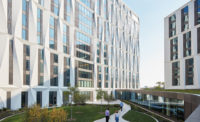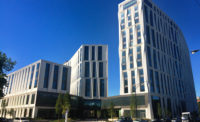Earl Shapiro Hall, University of Chicago Laboratory Schools
Starting at The Top: Carved masses and open spaces characterize the university-affiliated school for experimental education.


















Architects & Firms
Chicago
Like the institution it serves, the new early-childhood learning center of the University of Chicago Laboratory Schools is anything but ordinary. The $52 million, three-story Earl Shapiro Hall, designed by Joe Valerio of the Chicago firm Valerio Dewalt Train Associates, with FGM Architects, is as notable for its commodious, carefully conceived interior as for its exterior’s exuberant expression.
The building for pre-kindergarteners through second graders belongs to a tradition of Chicago-area education design for progressive schools that stretches back to 1940 and the Crow Island Elementary School in Winnetka, Illinois, by Perkins, Wheeler & Will, with Eero and Eliel Saarinen. Though it doesn’t match Crow Island’s exemplary synthesis of civic presence and village-like intimacy, Earl Shapiro Hall still offers lessons for forward-thinking pedagogy.
The renowned educator John Dewey founded the Lab Schools in 1896, shaping a curriculum that emphasized “learning by doing” rather than relying on rote memorization. Before Barack and Michelle Obama became President and First Lady, they sent their daughters Malia and Sasha to Lab. For decades, Lab’s early-childhood learning facilities were ensconced in and around this school’s neo-Gothic enclave, about seven miles south of Chicago’s Loop, which housed pre-kindergarten to 12th grade classes. Placing Earl Shapiro Hall a few blocks east of these friendly confines challenged Valerio to devise a fresh architectural framework that would simultaneously foster the school’s myriad traditions, such as piano-accompanied “sings” in the lobby, and open the door to even better education. That was a rare opportunity, and not just because the project had enlightened clients and a generous budget.
“Not many buildings have been built for our youngest children,” said David Magill, the Lab Schools’ director. “Usually, they’re in homes or in other buildings that have been renovated. To build one from scratch . . . is something you could only dream about.”
Valerio’s solution pairs a steel-framed administrative wing—topped by a cantilevered, “look-at-me” library—with a restrained classroom wing that’s mostly framed in precast concrete. These disparate parts are effectively tied together by an elegant cladding of oversized, cream-colored brick, energy-efficient glass, and perforated aluminum fins, arranged in a variation of the Fibonacci sequence. Confronted with a tight urban site, the architect transformed rooftops into outdoor “playscapes” and located small outdoor play areas directly outside first-floor classrooms, a feature reminiscent of Crow Island.
The outcome succeeds on several levels, the most important of which is that Earl Shapiro Hall’s airy, chiseled volumes project a welcoming openness. The building is of the city, more town than gown, but it doesn’t stray too far from the University of Chicago’s architectural roots. While making a contemporary statement with its folded south-facing facade, the design achieves a subtle allegiance to the Collegiate Gothic in its asymmetrical massing, projecting piers, and tracery-like fins. And while the exterior can be justly criticized for lacking kid scale—it could be a corporate headquarters for one of Valerio’s Silicon Valley clients—its boldness is not arbitrary. With the grandly scaled Museum of Science and Industry, a legacy of the 1893 World’s Columbian Exposition, across the street, Valerio either had to go big or go home.
The container expresses the innovative arrangement and spirit of its contents. The 13-foot-high light-washed corridors, 7 foot 9 inches wide in contrast to the typical 6 feet, exude a sense of calm—an important feature for educators dealing with an age cohort that delivers the daily tumult of broken toys and spilled milk. The floor-to-ceiling glass that encloses classrooms opens the building to its surroundings, including verdant Jackson Park to the east. Lab administrators characterize the ever-changing views as being, rather than a distraction, a novelty that will stimulate young brains. “Dead, really controlled space is pretty deadening,” said Valerio.
The most significant advance is the multiplicity of differently scaled learning spaces and their attendant flexibility. Paired classrooms share a small breakout room, where teachers can meet with small groups of students—or little builders can make wood blocks go clack-clack without disturbing a reading circle. Each classroom floor also has a glass-sheathed “learning lab,” larger than a typical classroom, that can serve as an indoor play space or a spot for dancing or other activities involving two or more classes. The interior culminates in the expansive truss-supported library, a beacon of learning, which also functions as a kid-friendly academic tree house.
To be sure, there are faults. The building’s glass-walled lobby lacks the old-shoe domestic scale of its counterpart in Blaine Hall, the James Gamble Rogers–designed Gothic Revival charmer that previously housed Lab’s early grades. “You don’t get that hugging space,” Magill said, adding that art or banners may be introduced to break down the scale and add texture. Nevertheless, Earl Shapiro Hall earns high marks as a thoughtfully conceived, precisely executed model of early-childhood learning. Here, modernism isn’t an aesthetic straitjacket but an enabling agent that gives a legendary institution new capacity to carry out its progressive mission.
People
Client:
The University of Chicago Laboratory Schools:
Design Architect:
Design Architect Personnel:
Architect of Record
Architect of Record Personnel:
Structural Engineer:
M / E / FP Engineer:
Electrical Engineer / IT:
Sustainabilty Consultant:
General Contractor
Photographer(s): Size: 128,000 square feet Cost: withheld Completion date: July 2013 |
Products
Structural system
Manufacturer of any structural components unique to this project:
Exterior cladding
Metal Panels:
Metal/glass curtain wall:
Precast concrete:
Curtain wall:
Roofing
Glazing
Doors
Interior finishes
Suspension grid:
Cabinetwork and custom woodwork:
Wall coverings:
Plastic laminate:
Floor and wall tile:
Resilient flooring:
Carpet:
Special interior finishes unique to this project:
Lighting
Dimming System or other lighting controls:
Conveyance |















